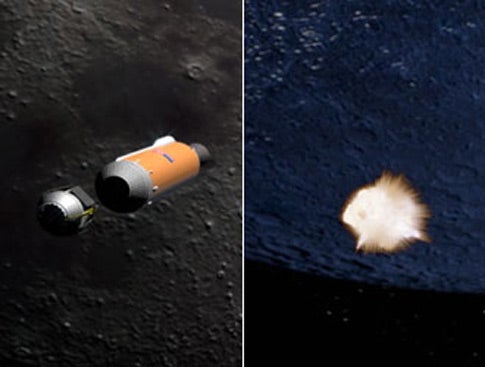In October 2008, NASA plans to send the Lunar Reconnaissance Orbiter (LRO) to study the Moon’s surface in preparation for the return of humankind. The space agency recently added a secondary payload to this launch. The Lunar Crater Observation and Sensing Satellite (LCROSS) will join LRO aboard the Evolved Expendable Launch Vehicle that will launch from NASA’s Kennedy Space Center.
After launch, LCROSS will disconnect and reach the Moon independently. As LCROSS approaches the lunar south pole, its Earth Departure Upper Stage will separate, and then impact a crater in the region. The remaining Shepherding Spacecraft will fly through the plume generated by the upper stage and analyze the cloud for evidence of water. Space and Earth-based instruments also will watch the show. The research will help determine landing sites and available resources.
“The LCROSS mission will help us determine if there is water hidden in the permanently dark craters of the Moon’s south pole,” says Marvin Christensen, manager of the Robotic Lunar Exploration Program, which proposed the secondary payload. “If we find substantial amounts of water ice there, it could be used by astronauts who later visit the Moon to make rocket fuel.”
LCROSS was not part of the original launch design. NASA called for internal proposals that will advance lunar science and assist in the return to the Moon. These ideas will fit within the payload capability of the launch vehicle at a low cost, with the hopes of yielding high returns.
This duo is the first in a series of robotic missions that NASA will send to the Moon. Between 2008 and 2016, these missions will examine and map the lunar surface in preparation for astronauts’ return to the Moon.










